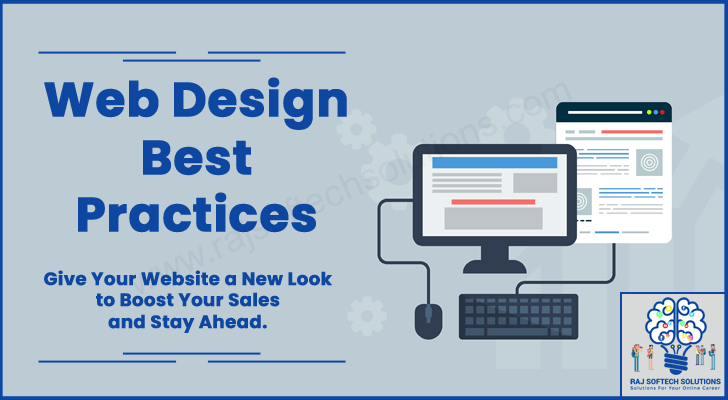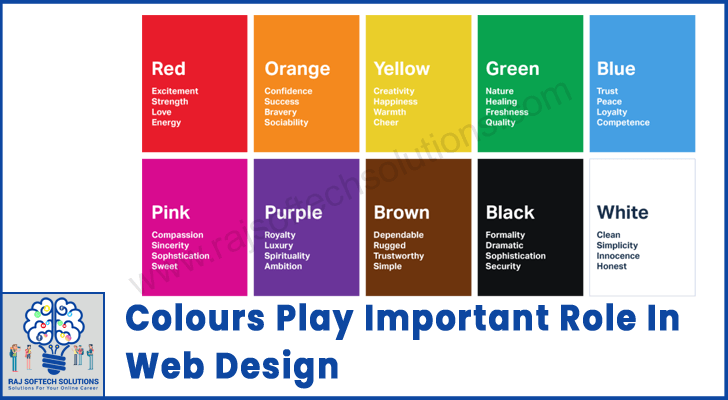Stay ahead of your competitors with our list of web design best practices for 2025. This article covers the latest trends and techniques to help you create beautiful, engaging, and user-friendly websites.
Since the invention of the internet, the world has become smaller. We have access to information of all kinds at our fingertips.
The internet is a wonderful world that continues to revolutionize our lives. Nowadays, most people spend time on the Internet watching videos, reading news, and doing other activities.
Because of the amount of time spent on the internet, enterprise website owners have recognized the value of being online and also have begun to move their services and businesses online. Every business needs a website today.
Every business needs a website today. A company that does not have a website is missing out on various business chances and potential consumers.

A well-designed website is a need to achieve the objectives. (e.g., convert online visitors to regular customers). A well-designed website will be straightforward, simple to use, and easy to browse.
The design will attract web visitors, keep them engaged, and effectively hold their hand while they explore the online platform.
One example of logical web design in action is an easily visible menu bar at the upper side of the website’s homepage. To be sure, a great website requires far more than a menu bar.
But what exactly makes an excellent website design? Let’s look further into the article.
1. Web Design Best Practices in Layout And Design
So much trade is made online that is no longer just “nice to have”. It is mandatory. A seemingly little design detail, such as a clear menu bar, can make or break a relationship with a potential consumer.
A website visitor may struggle to identify the webpage they require if this minor but significant element is not present.
In the worst-case situation, the visitor may become so irritated that they skip the website, resulting in a missed chance for the brand or business seeking to win over that potential consumer.
Here are a few things you should follow for the best web design.
1.1. Simple and Clean Design
While the design of your website is essential, most visitors aren’t coming to see how flawless the design is. They want to finish a task or find a specific piece of information.
As a result, useless design components (those that provide no useful purpose) will only confuse visitors and make it more difficult for them to accomplish their goals.
From the standpoint of usability and user experience, simplicity is your closest buddy.
When you have all of the necessary page elements, it’s difficult to go too simply. It is critical that your website is scannable and your material is understandable.
Being aware of your user’s mental demands is good practice. You don’t want to overwhelm your audience with a barrage of colors, graphics, and copy.
Make your website simple and engaging for them by using a clean look and relevant information.
Creating a visual hierarchy is one method. It is the orderly arrangement of all the design elements of a website.
- For example, if a headline is wide, contrasting in color, and centered on a page, it stands out more than something smaller, not particularly colored, and misaligned.
- It’s also essential to make good use of white space. White space is the ‘negative’ space between layout elements, paragraphs, and graphical components.
When you design with white space in mind, your material will be more scannable, digestible, and easier on the eyes.
1.2. Proper Use of Colours and Typography

When it comes to branding, color is a key design aspect. You’ll enter the web design process knowing what color scheme you want for your business. It is important, to begin with, a mood board for your brand while designing a website.
Choose a primary and secondary color, as well as a lighter and darker shade for each web element (the secondary color can contrast or contrast the primary color).
Color should be used carefully so that your eyes do not get sore. Also, when choosing a color, keep in mind that colorblind people account for up to 4.5% of the global population.
As a result, ensure that your design is still functional for folks who may not be able to distinguish colors.
Another crucial branding factor is site typography. While there are numerous sources for suitable fonts to utilize on your website, you should first explore choices that will display consistently irrespective of the fonts installed on the end user’s machine.
Google Fonts provides a large range of free web-safe fonts that will display correctly regardless of the user’s installed font style. Include fonts on your mood board to determine whether they match your color scheme.
When it comes to choosing typographic elements based on web design practices, choose sans-serif fonts for titles and serif fonts for text as a general rule.
On the absolute least, avoid using attractive typefaces for body material because they are difficult to read.
3. Focus On Usability and Accessibility
To begin, let us define website usability. Website usability is a feature of sites and a design approach that concentrates on the user’s demands.
It employs user-focused design approaches which makes websites well-organized and straightforward for people.
The two aims of website usability are clarity and utility, and designers must prioritize both. In other words, websites appear nice and function as expected by consumers by web designers.
Making your website accessible to individuals including those with impairments is called accessibility. Website accessibility is an important goal since it allows all people equal access to your material.
You may be asking who is in charge of the web accessibility program and who is responsible for enforcing norms across the internet.
Members of The World Wide Web Consortium’s (W3C) Web Accessibility Initiative (WIP) publish the Web Content Accessibility Guidelines (WCAG) and related material.
By focusing on the accessibility of your website, you will improve the user experience (UX) for all of your users, including those with impairments or constraints who visit your site.
You’ll demonstrate to your customers that you value and care about them as individuals, enhancing brand loyalty and support.
2. Web Design Best Practices in Website Optimization
Every small modification you make to your website can influence the number of conversions you observe and how people connect with a brand overall.
It is important to survive in a digital age, to have a solid plan behind the design of your website, to use best practices, and to know how you want to display your company online.
Here, let us see the best design practices in website optimization.
2.1. Buying the Reliable Web Hosting

A website is hosted when a hosting company allocates space on a web server for a website’s files. Web hosting holds the files that make up a website (code, graphics, etc.) viewed online. A server hosts a website you’ve visited.
In other words, web hosting is the practice of renting or purchasing space on the World Wide Web to house a website. Website assets such as HTML, CSS, and images are stored on an online server.
If you want to establish an online presence, you’ll need reliable web hosting. Today, there are hundreds of technology providers offering thousands of different types of web hosting services.
Plans range from free with minimal options to pricey business-specific web hosting services.
The hosting plan you select will be determined mostly by how you plan to use your website and how much money you have for hosting.
Selecting the correct hosting service will provide you with access to the resources you need to keep your website loading swiftly and reliably for your visitors.
Consider how many businesses nowadays operate mainly online; their sales and business leads are generated through their website.
Clients will not wait if the website has a problem. They’ll leave that site in search of one that operates properly and smoothly and delivers what they’re looking for.
2.2. Optimizing the Website Code
Elements on the web page can be optimized. This is critical for search engine optimization because ranking factors consider loading time when putting the site on SERPs.
Proper coding in web design methods on a web page can lighten the page by up to 25%.
- Remove any additional spaces between tags after the attributes and punctuation at the beginning of the line.
There are several computer apps and internet tools available to assist retrieve every last part of a byte from HTML coding.
The methods available follow the same principle. The online tools are really simple to use; simply enter the URL into the page form and it will give the optimized code for that webpage.
2.3. Ensuring Fast Loading Time
Site speed is an important part of web design best practices in this year. A slow website irritates more than just your customers.
Users will frequently leave a slow site, which might have huge consequences for your firm. Google considers site speed when deciding search rankings.
Pingdom and Website Audit are two free tools that may provide site performance information fast.
A website with many design elements will load slower than one with fewer design elements.
- The usage of different typefaces and font sizes is one example.
- Loading a graphics library or framework can also cause your website to slow down.
To prevent slowing down your website, carefully analyze each design feature on the list of web design best practices.
2.4. Search Engine Optimization
Search Engine Optimization is a crucial element of web design best practices for Indian businesses. Some SEO best practices include optimizing your website structure and navigation and ensuring that your website is mobile-friendly.
SEO also involves incorporating the right keywords in your website content and metadata. A web design company should pay attention to these basic details while designing your website.
By incorporating SEO best practices into your website, you will increase your chances of ranking high in search engine results pages (SERPs) and attracting more visitors.
Search engines monitor websites to see whether they include relevant terms that users are looking for. The more your content responds to your visitors’ searches, the more genuine traffic you’ll get.
2.5. Mobile Optimization
In today’s society, most people access websites using their mobile phones. As a result, every website must have a mobile-friendly design.
Approximately 80% of customers will abandon a website if the content does not display properly on the device they are using. A simple solution is to use a responsive web design, which automatically adjusts the page to fit the size of the browser.
Understanding how your intended audience interacts with your content enables you to design a website that is both useful and pleasant to use.
One strategy to optimize your website is to create a mobile-first and mobile-friendly website.
There are several boundaries when it comes to designing for mobile. People interact with content differently on mobile devices than they do on desktops or computers.
These restrictions, on the other hand, can be beneficial. They provide a lighter and more understandable website.
With a mobile-first design, you can help optimize every user experience, regardless of how they engage with your content.
2.6. Regular Software Updates
Building a website is not an easy matter and is not finished once it is online. Updating your website is an important step in your company’s growth and brand.
It is a method of keeping your material up to date, informing your clients about new items and services, and increasing the SEO value of your website.
People who visit your website view it as a reflection of your company. Readers will consider you an authority and expert if your site appears professional and contains relevant information.
Similarly, if the site appears poorly designed, and/or out-of-date, people will make the same conclusions about your business.
Below are some of the Website security best practices for India;
- The website should promote your product or service, and the layout should be aesthetically pleasing and appropriate.
- Out-of-date content should be removed or updated.
- If your website is developed on WordPress, ensure to update WordPress Core, WP themes, and plugins at regular intervals.
- Create a habit of checking your website codes, files, and folder for any malicious scripts, files, images, etc.
- As websites evolve and grow, it is common for specific components to stop performing properly and become obsolete.
Check our affordable WordPress website maintenance services starting from just Rs. 1999. And you can ensure that your website is always up-to-date, secure, and performing at its best.
2.7. SSL Installation
An SSL (Secure Sockets Layer) Certificate creates an encrypted link between a server and a browser, ensuring that all data transmitted between the web server and browsers remains secure.
With Google’s push to make all websites secure and publicly display whether a website is secure or not, it’s no longer just for e-commerce companies or transactional websites.
The certificate allows your website to load with the HTTPS prefix and obtain that small green padlock to protect and comfort your website visitors.
Let’s Encrypt open-source certificate projects are offered by many hosting firms. All of this encryption and certificate language may sound harder, but Let’s Encrypt makes installing a certificate a breeze with just a few clicks.
You can do it in three steps:
- The hosting control panel should enable Let’s Encrypt.
- Install the Simple SSL plugin and activate it.
- Update your Google Analytics and Google Search Console properties.
Final Thoughts
These web design best practices are followed by almost every website you browse. There will always be exceptions to the rules, but recognizing them will make it easier to break them without ruining your idea.
Taking the time to adopt these website design ideas can result in major improvements to your website’s performance, usability, and consumer conversion rates.
However, after using some of these website design guidelines, you may believe that the big project at hand is redesigning your website.
If you plan to revamp your website, give us a quick call from one of the finest web design companies in Coimbatore, Tamilnadu.
With over ten years of experience in designing and developing several business websites, we gained a reputation over the years.
Our custom web design services are tailored to meet the needs of every client.
